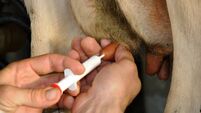Paula Hynes: Do you have a beef with the cost of living?

The cost of beef for the consumer has risen 22% year-on-year.
The cost of living, along with food inflation, is making the headlines — one politician even said “a litre of milk is now more expensive than a litre of petrol”.
There is some bit of truth in that statement, but in reality it is a headline grabber — if the same politician shopped own brand in a supermarket, they would get their litre of milk cheaper than petrol, and if the cost of diesel came down, the price of food may do the same, as there is a lot of transport involved in collecting milk from farms, delivering food to distribution centres and then onwards to supermarkets. And let's not forget contractor charges, which have risen dramatically due to the cost of diesel.
I might remind the same politician that while petrol may be cheaper than milk, oil companies make far greater profits than dairy farms. In fact, thank God the price of milk is high. Irish dairy farmers spent most of 2023 and 2024 operating at break-even as the price of milk was so low.
The price of food will need to remain high in Ireland — there are further taxes being placed on fertiliser next year, there is also a proposed tax of €80 on a tractor tyre, energy prices are far too high in this country, and diesel the same, meaning the cost of producing milk is high and will only go higher going forward.
Ask yourself this: why do politicians start to spout dramatic headlines when the voter and consumer have their backs against the wall?
Politicians are still wrangling over regulations which may further impact the price, will the derogation be renewed, and now the mighty EU wants to play with the CAP budget, well if they reduce it, the consumer will pay the price.
There are talks the budget will be reduced by 22% between 2028 and 2034. Remember, the CAP was originally set up to keep the cost of food low, and the EU has already been reducing those payments to farmers for years.
Milk isn’t the only food that has risen in cost, the cost of beef for the consumer has risen 22% year-on-year. It seems high, but the price of cattle has risen 48%, according to CSO figures. Beef kill at factories is reducing week on week, with prices climbing, which will further increase the price for consumers.
The writing was on the wall for high beef prices for some time, and yet politicians continued to walk around in La La Land, oblivious to a looming beef shortage. When Pete was in the US in 2023, Angus calves from dairy herds, which were still being fed milk, were costing $450 each. The same calf here was costing between €50 and 100.
Why the price difference? There was a massive shortage of beef cattle in the US. Ground beef has risen by 50% in price over the last five years in the US, beef production is forecast to drop by a further 2.1% this year, which equates to 600,000t, and the US beef herd has fallen to its lowest in 70 years — an 800-pound steer in the US cost about $1,500 in 2024 and now costs $2,400, prices which are forecast to continually rise through 2025.
It is not just a US issue — in Ireland, changes to derogation rules by the EU meant Irish farmers had to reduce dairy cow numbers to the tune of nearly 200,000 cows.
If we assume a 10% non-pregnant rate, then that is 20,000 fewer cows going for slaughter a year, and 180,000 fewer calves born, so the beef kill in Ireland was forecast to drop, and it has.
In fact, the beef kill in Ireland is in free fall at the moment, and not only will have an impact on beef prices in the supermarket, it also has a serious economic impact on our economy, and may potentially lead to job losses.
On an EU level, beef cow numbers are at their lowest since 1961. EU politicians have simply regulated farmers out of business — those farmers who continued have been crippled by the rising cost of farm inputs, and while many farmers continue, climate change is now driving them out of business.
Farmers in Mediterranean countries have now ceased trying to rear young calves due to the challenges of extremely high summer temperatures, and have now switched to sourcing older weanling cattle from Northern Europe, including Ireland, as these older cattle can adapt to high temperatures with fewer health issues.
Export demand for cattle to other EU countries from Ireland has never been higher, and looks to increase. The EU political solution, to simply sign the Mercosur deal, and ensure you will all be eating South American beef, which in turn will further push EU farmers out of business.
In the end, we will be simply paying a high prices to Brazil for beef because other countries across the world will also be looking to source the same beef due to a global beef shortage, which is forecast to increase as global demand continues to soar over the next decade.
The great Texas ranchers would most likely say to politicians, y'all made a mess of it, and they would be right on the money with that statement.
The same politician who feels a litre of milk is higher than a litre of petrol might also remind her political party MEPs to actually turn up and vote when it comes to EU agricultural parliament voting, because their record of voting is pretty dismal and bordering on non-existent up until now. They simply didn’t seem to care about EU agriculture or food production until it became a huge issue for consumers.
On a cheerier note, with no shows since the Great Yorkshire due to a few hospital appointments, we are all set for YMA National Finals in Kilkenny, and with seven heifers travelling, we have two top-class days of showing ahead, so hopefully we might have a little luck.


